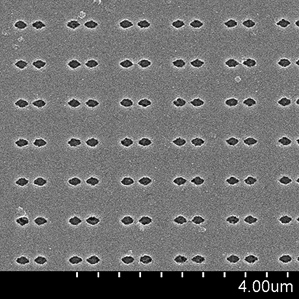Startup Uses Novel Materials Based on Plasmonic Effects
A startup focused on developing novel optical materials received $1 million in first-round funding last month from the venture capital firm Quantum Wave Fund to advance its early-stage technology. Nano-Meta Technologies, based in West Lafayette, Indiana, is developing prototype hard drive heads that could improve the storage density of magnetic disk drives, as well as nanoparticles that could be used in light-driven cancer therapies.

Nano-Meta Technologies was spun out of the Purdue University labs of Vladimir Shalaev and Alexandra Boltasseva last year. The company is developing nanostructured compounds that can concentrate light through plasmonic effects to surmount a hurdle called the diffraction limit, which affects the resolution of light microscopes and lithography.
Lenses made of traditional materials can’t focus light onto a spot smaller than half its wavelength. But when light shines on a suitable metal surface, some of its energy gets coupled to the surface in the form of a plasmon—a quantum particle of plasma oscillation. Plasmons carry energy but can be confined within a much smaller physical space than is normally possible with light.
Over the past decade, researchers have been playing around with the possibilities this opens up. In the realm of data storage, for example, plasmonic structures can create a much more tightly confined beam of light that can read and write much smaller magnetic or optical bits. In medicine, gold particles just tens of nanometers across could be used to damage tumors by concentrating the energy in infrared light.
Shalaev and Boltasseva have been working on controlling plasmonic effects in various ways, not just through the structure and chemistry of materials. Boltasseva (named a TR35 winner in 2011) has developed new plasmonic materials, including titanium nitride and metal oxides, that can be tuned chemically and are compatible with existing manufacturing methods.
Nano-Meta Technologies is currently working on a prototype read-write head for magnetic data storage that it hopes to sell for future generations of heat-assisted magnetic recording (see “How Seagate’s Terabyte-Per-Square-Inch Hard Drive Works”). This type of data storage involves flipping the polarization of sections on the storage medium by using laser light to heat the material. As memory cells are miniaturized to improve storage density, manufacturers will need light sources that can produce ever narrower beams of light.
Another area the company is investigating is cancer therapy. Metal nanoparticles can be injected into the bloodstream so that they accumulate in tumors. When clinicians shine the right wavelength of light on these nanoparticles from outside the body, some plasmon oscillations heat them up and damage the tumor. It is possible to control how much the nanoparticles heat up by altering their shape. Nanospectra Biosciences of Houston, Texas, already has treatments based on gold-coated nanoparticles in early clinical trials.
The approaches Nano-Meta Technologies is focused on are relatively new even in academic settings, but the company and Quantum Wave Fund are betting that the time is right to push them into commercial applications. “We believe there are a couple low-hanging fruits,” says Serguei Kouzmine, managing partner at Quantum Wave Fund.
Kouzmine says the fund hopes to see some return on its investment in the form of licensing deals in about three years, but the company does not have firm deadlines for product development.
Keep Reading
Most Popular
Large language models can do jaw-dropping things. But nobody knows exactly why.
And that's a problem. Figuring it out is one of the biggest scientific puzzles of our time and a crucial step towards controlling more powerful future models.
How scientists traced a mysterious covid case back to six toilets
When wastewater surveillance turns into a hunt for a single infected individual, the ethics get tricky.
The problem with plug-in hybrids? Their drivers.
Plug-in hybrids are often sold as a transition to EVs, but new data from Europe shows we’re still underestimating the emissions they produce.
Stay connected
Get the latest updates from
MIT Technology Review
Discover special offers, top stories, upcoming events, and more.